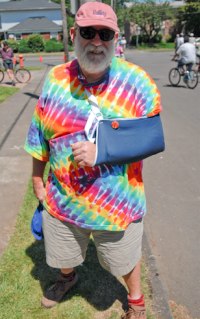
(Photo © J. Maus)
Vancouver, BC resident Ron Richings has visited Portland for the past several years to take part in the annual Pedalpalooza events. On June 26th, he was leading a ride of his own — the Momentum Meander — when he learned a hard lesson about one of Portland’s most prominent bikeways.
Richings was riding north on the Eastbank Esplanade. As he descended down the ramp that leads to the floating portion of the path (under the Burnside Bridge), his bike hit one four bumps that act as transitional lips between ramp sections. The bump shook his bike, causing a bungee strap to dislodge, become entangled into his wheel and crumpling his front fork. He flew over the handlebars and landing on the concrete walkway. Richings ended up in the hospital and still has pain in his shoulder.
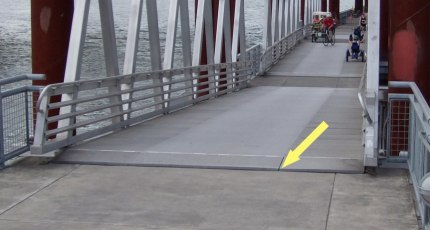
Doug Sottoway saw the crash and said, “It was a 10 in terms for crash horrifics.”
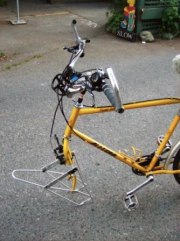
(Photos: Ron Richings)
Many Portlanders have stories about these bumps. They are only an inch or two in length, but their extreme angle makes for a jarring experience — both physically and audibly — when you roll over them. The bumps have claimed numerous victims.
After his crash, Richings returned to the spot to examine the bumps and talk with other riders. “I heard repeated tales of injuries, ambulance calls, damage to equipment, and loss of accessories like headlights, blinkies, and similar stuff. Appears to be a well known hazard by those who live in Portland, and a potential trap for visitors like me.”
“To have a major transportation route with a built-in hazard seems bizarre to me – particularly for a city putting so much focus on cycling infrastructure.”
Richings then fired off an email to the City of Portland Bureau of Transportation (PBOT) to share his experience and his concerns. “To have a major transportation route with a built-in hazard seems bizarre to me – particularly for a city putting so much focus on cycling infrastructure,” he wrote.
The section of the Esplanade where these ramps are located falls under the jurisdiction of Portland Parks and Recreation (which might explain why no one from PBOT has replied to him yet).
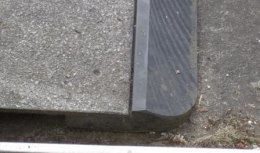
George Hudson, currently a consultant with Alta Planning, helped design the ramps as a member of Parks’ staff when they were designed back in 2000.
When I asked him for information about the bumps (he calls them “aluminum transition plates”), Hudson pointed out that the entire system was designed to move with the tides. “Some people don’t realize that the gangways and floating walkway are dynamic, they move. The transition plates on the gangways are the most dynamic pieces of the system, they move the most, making up the grade difference between each gangway.”
Hudson also acknowledged that they make a loud noise when hit by someone on a bike, and that, “We did not see that as a bad thing when we designed the walkway, they give an audible warning by default, and I’d say they have an added affect of slowing people down, though the plates were not designed with that in mind.”
Hudson says if there is evidence of crashes, he thinks the plates could be replaced with longer plates that transition the grade more evenly.
Parks department spokesperson Beth Sorensen says their Risk Management division has no reports of incidents. In the course of doing this story, I have brought the issue to Parks’ attention and they have committed to visiting the site to do an evaluation. Sorensen says the first thing they might be able to do is add warning signs. She’s also working to find out a hotline phone number people can call to report crashes in the future.
Meanwhile, Richings has begun physiotherapy for his shoulder (doctors say it will take 6-8 weeks for inflammation to subside) and he remains perplexed that the problem has persisted for so long:
“In a properly designed and built path the city would make sure that such hazards are corrected, not rely on riders to compensate for them. Would something like this be allowed on I-5? Of course not… It isn’t enough to build infrastructure. There has to be ongoing maintenance and review of problems to make sure that the system is cycling-friendly.”
I’m planning to visit the site with a Parks employee and someone from the Bureau of Transportation in the coming days. I’ll keep you posted on any developments.
If you have ridden over these bumps, please share your experiences and ideas for solutions below.
UPDATE: Here’s the official statement from the Parks Bureau:
Two recent incidents on the floating docks along the Eastbank Esplanade have been brought to the attention of Portland Parks & Recreation. Specifically, two accidents by cyclists have occurred on the edges of the floating pathways.
All users of the Eastbank Esplanade, and specifically the floating walkways, need to be aware that this is a dynamic environment and the ramps and their edges are a complex structure designed to accommodate the location, which is functionally similar to entering a ramp to a boat dock. These edges were design to allow the dock to move with the rising and lowering water levels in the river. Because the river levels fluctuate daily, as well as seasonally, the edges of the ramp can become higher or lower in a very short amount of time.
Our Services staff is evaluating the site and any issues which might have contributed to the two recent incidents and will explore measures to mitigate the situation. Staff hopes to meet on site with cycling community representatives, to clarify issues and obtain their input from the cycling perspective.
In the meantime, staff is already looking at improving signage at those sites. While existing signs alert cyclists to use caution on the floating ramps themselves, additional signage is being considered that calls attention to the bump at the edge of the ramp.
Cyclists should exercise particular caution at those locations, just as you would crossing over a train or streetcar track. Slow down and approach the ramps straight on, and not at an angle.
Prior to these incidents, PP&R had not received notice of any safety concerns associated with this specific issue.
If people experience accidents or witness incidents on the Eastbank Esplande, they are encouraged to contact Barbara Aguon, PP&R Risk Manager, at 503.823.5478 and file an incident report.

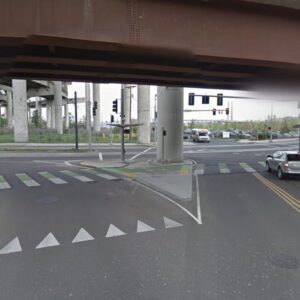

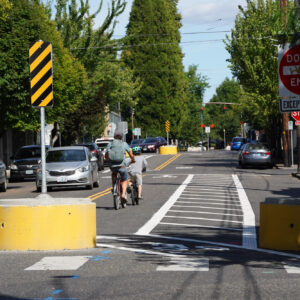
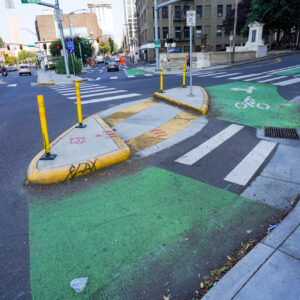
Thanks for reading.
BikePortland has served this community with independent community journalism since 2005. We rely on subscriptions from readers like you to survive. Your financial support is vital in keeping this valuable resource alive and well.
Please subscribe today to strengthen and expand our work.
I’ve ridden over the bumps, and while I never saw them as particularly hazardous, they are very uncomfortable and inconvenient. I can see though if you didn’t know they were there and you were going a little too fast…
I agree with Richings comment, that it’s unlikely something like this would be allowed to remain on a main road where the primarily impacted demographic was automobile users.
Granted, I feel the overall danger of this section of path is pretty low (relative to a lot of other things), but it should definitely be evaluated to see if there’s a feasible way to make it better.
Seems like the blame primarily lies with a weakened fork, and not a small bump. Folding a fork like that just doesn’t make sense with a bump that small. It looks like he hit a curb head on at speed.
I get the impression you’ve never actually ridden on those ramps. “Small” is relative. When I first moved to Portland in 2013 they had already been leveled out a bit but still seemed too harsh. A bridge engineer needs to explain why they can’t be made milder still. I suspect they might break from flexing or something.
Sorry to hear about the accident, and I hope the gentleman recovers quickly, but I’ve ridden over those ramps on a carbon fiber racing bike(read: stiff) numerous times, and I’ve never had a problem. They are noisy and a little jarring, but I always stand to absorb some of the shock. Bunny hopping helps even more. I actually think that whole floating pathway system is a pretty impressive engineering feat.
Yeah, I hate those things. I ride south on the west side just to avoid the jarring bumps. If my tires are a little low on air, I always fear a pinch-flat when my wheel comes in contact with those plates. That would be sweet if Alta retro-fitted some longer, smoother transitions.
I’ve spent a lot of time on the Esplanade–both on bike and on foot–and I’ve never seen or heard or experienced any problems with these bumps until I read this article.
Was it the fork, or the bump that was the cause?
He is lucky he does not have more injuries from a front fork breaking.
Seems like a longer plate would solve this.
In Waterfront Park during Rose Festival (and other events) they used to have covers where electric cords passed over the sidewalk that were short (about a foot or so) making an abrupt bump. More recently they have been using wider covers making them more like a street speed hump. Much better.
I have wider tires so never have much risk there, but I don’t like them. Those jarring bumps are hard on the bike. I wonder now how my fork is doing if his crumpled from the impact.
I think they take a toll after awhile. They are jarring and in wet weather can create a bit of a slip hazard too.
This is my winter route to work (I have a new one for summer to avoid the crowds on the espalanade and now to the steel bridge as well)
I have thought to myself several times they could be smoother joins. I am bad a bunny hopping and it’s still jarring even at a slower pace.
A little bump like that shouldn’t fold a fork like shown in the picture, there’s got to be more to the story here. I wonder if it was already weakened and ready to fail–if that were the case, any imperfection on his route could have done him in. I’ve seen people smack a curb head on at speed and wipe out, ruining their wheel but the damage to that fork just seems excessive according to the description of the accident.
I lift the front wheel, but that goes without saying for high pressure tires. Making it easier to go faster may frighten pedestrians or lead to crashes for uncontrolled cyclists.
The wife and I saw someone’s front fork crumple on these ramps last summer, a horrific sight to be sure.
Those are more than just little bumps. I regularly have a choice of whether I exit the waterfront by going up the ramps toward the convention center, or continue down to Taylor Street; those bumps are definitely on the list of cons when making that call. I don’t fear an accident from them, just wear and tear on my bike and my nerves.
I’ve always found the bumps just a noisy inconvenience that is easily bunny-hopped. I too can’t imagine that the bumps alone would cause a fork to fail that catastrophically.
Hell, to do that kind of damage on my old BMX bike I had to endo from 5 feet in the air!
I bunny hop over the bumps at speed. If there are people in the way i either bunny hop over the people as well or just slow down to about 5-10mph to pass politely. Pay attention to the road and your surroundings and you will be fine.
Wow, sorry to hear about this and hope the guy recovers, but wonder what kind of condition the fork was in that it would simply crumple like that? I mean, sure these bumps can be somewhat “jarring” but it is not that easy to go fast on here with all the rollerbladers, joggers, pedestrians and baby strollers so I tend to go slow on them.
Those bumps are the reason I switched my commute. I would love to ride the eastbank and drop over the morrison bridge right to my job. Instead, I go over the Steel and ride through downtown. To me, downtown traffic is safer and more comfortable than riding over those bumps. Also, what’s up with that ramp on the east side of the Morrison bridge? Am I the only one who gets dizzy going down it?
Jonathan:
The bumps have claimed numerous victims.
Where’s your evidence for this? In the story one person says he heard that they’re dangerous, the other one says there are no incident reports. If you’re going to write the above, shouldn’t you provide evidence that confirms the statement?
Slow down?
That 1″ transition piece bent his forks BACK that far? Maybe he is too big for that model of bike, or the forks are defective. Looks like he hit a curb straight on.
these things are freaking annoying. i’m glad someone raised this issue. my thumb has been hurting from getting streetcar’d in NW 🙁 and every time i go over these things it gets jarred. i have taken my injured hand off the handlebars to compenasate, but maybe we could smooth this out so that riders get a more comfortable experience.
just because it is tolerable for most doesn’t mean it shouldn’t be improved
I was on Ron’s ride, and called the ambulance for him. Glad to hear he’s getting better. I avoided the Esplanade before because of these joints; now if there’s a bridge lift and I am diverted, I slow way down to cross them.
It looks to me like this is a fork problem and not a facilities problem. There is no way that you could fold back a structurally sound fork like that on a transition as small those found on those ramps. It is hard to tell from the picture but that looks like an older lower quality steel bike that reached the end of its fatigue life. Even so, by the look of the deformation I would have to guess that the rider may have been surprised by the loud “clack” as he hit the transition and slammed on his front brake causing it to fold back. I hope the rider heals quickly. Accidents happen and I’ve had my fair share. It is often hard to remember exactly what happened when you are the rider.
I see that it has a rack on front. Did he have something heavy on it? I could see that possibly being a factor.
But, seriously other than maybe some signage that says “Slow, Sharp Bumps Ahead” I am not sure what else the city could do.
Those things are annoying. I’ve lost a couple lights before, but never thought they might cuase that bad an accident. Looking at the pic above, it appears that the fork bent back but didn’t fracture. So it doesn’t seem like it was due to old equipment. If there was a problem with the fork, I would expect one side or the other to fail. Not both sides at the same time and same rate. But maybe the picture is too small to tell.
Please note: I have updated the story to clarify that the bump did not directly crumple Rob’s fork. The bump shook a bungee cord loose, which got lodged into his wheel and ultimately caused his fork to bend.
I recently rode both the east and west portions of the esplanade with a friend visiting from out of town. She definitely falls into the “interested but concerned” category of bicycle rider. The up and down ramps scared her and were definitely her least favorite portion of the entire ride.
If we’re serious about the Bike Master Plan (and I know I am) then I think we need to address trouble spots like these with more than just warning signs. While I imagine the majority of bikeportland readers don’t find anything intimidating about bunny hopping the bumps, this is a piece of infrastructure that is meant to serve a much wider audience. We can do better.
That’s a big guy, and if he had all his weight on the front…
I’m going to venture that it’s the <1" ramp toe that is difficult to negotiate on a bike, not the angle of the ramp itself as is purported in the article. Unfortunately, that dimension is probably a lot harder to change than the angle of the ramp. A slimmer toe with a longer bevel may not be durable enough, and a damaged ramp toe would cause more problems than the existing situation.
Seems a lot like streetcar tracks to me – just another known hazard to be cautious of. Potholes and other bumps get people all the time, but they're ubiquitous so people accept them. There aren't many other tidal-adjusting floating path ramps to compare this to, so it appears exceptional while the condition (a <1" bump) is really quite common. Nonetheless, it seems worthwhile for Portland Parks to check if there's a feasible improvement to be made.
Here's hoping Ron makes a full recovery.
BTW, it sounds to me like the guy had a bad fork, and the reason why he crashed was because the fork failed as he went over the bump. I Aegis (carbon) frame with a carbon fork, I went over those bumps twice a week for two years, my frame and fork survived that without crumpling. I’ve never seen anybody crash on the bumps. Given the relatively small nature of the bumps I can’t imagine a fully-functional fork failing the way this one did. That this guy is blaming the bumps for his crash says more about him than it does about the safety of the Esplanade.
If you’re hitting those ramps at anything over 5mph. You’re doing it wrong. You’re descending to a floating causeway for crying out loud. You have no idea how much play there will be until you get to the bottom.
Uh, perhaps you could learn to ride your bike, sir?
OH MY GOD! A BUMP! exactly whom do I sue?
Someone mentioned that it looked like he hit a curb head on at speed….that’s what going over those bumps feels like. I’ve never witnessed a crash but my friends and I have had multiple pinch-flats resulting from these, which are a pain when you are commuting to and from work. Longer plates seems to be the best solution. They would still allow for the tidal fluctuation. The noise is a much smaller issue.
Thanks Jonathan (#26), that changes things a bit.
And can we get off the bunny hopping thing? Should I really tell my mom that they aren’t annoying because she should just bunny hop them?? How does my daughter bunny hop the trailer??
They are at least annoying and in certain, rare instances can be worse (lost lights are expensive, and suddenly released bunggies on a front rack are obviously a problem).
I’m not saying they NEED to be changed, but it sure would be nice if they were.
Ironic that the ride description said:
I hope he recovers well. Certainly seems like the transitions could and probably should be 200 to 300% wider in breath to ease the transitions as the level of the river can greatly influence the difference profile of the floating sections.
it looks like the forks may have been defective. I’ve ridden across those numerous times with stiff carbon forks. I usually float my center of gravity way, way back when I get to them. I noticed that he’s got low-riding pannier racks up front, was this bike fully loaded for touring? perhaps excess cargo weight may have contributed to the incident?
on a side note, those steep angle ramps, however small, do make for a sharp jab, especially at any reasonable speed. longer, and shallower ramps would make the floating portion of the esplenadé much more pleasant.
Now that we’ve clarified the cause of the crash (#26), I don’t feel this article takes an open and honest approach to the situation. Yes, it sounds like the bumps are worth a discussion, but they didn’t cause this crash. They might have caused other crashes, and probably a lot of pinch flats for people with under-inflated tires, but not Ron Richings’ crash. The bungee cord is the real “nasty little bugger” that should be in the photo.
There’s no way the City needs to test whether bumps on its bikeways are capable of dislodging bungee cords.
“I’ve ridden over the bumps, and while I never saw them as particularly hazardous, they are very uncomfortable and inconvenient. I can see though if you didn’t know they were there and you were going a little too fast…”
This kind of thing makes me a little mad–not because it’s particularly dangerous (I don’t ride here, so I don’t know how bad they are), but because as Richings implies and Dave points out, it highlights the double-standard (intentional or not) between requirements for automobile travel routes vs. travel routes for everybody else. If such a thing were built into a roadway used by motor vehicles, signs would call them out ahead of time (“WARNING, bumps ahead”) AND they would be painted in some way to make them visible. Hudson says they have an “added [unintended] effect of slowing people down”, like it’s a good thing. It may well be a good thing to get folks to go slower here (again, I don’t ride here, so I don’t know), but for crying out loud, don’t “slow people down” by putting in sneaky hazards that slow you all the way down to the concrete.
That changes thing a whole lot. I knew there was more to this story and turns out there was a lot more to it.
Damn those recalcitrant bungies. I hope the rider makes a quick recovery and gets back on the road.
I’m not sure how the city could ever reliably test for the bungie-busting ability of curbs and bumps even if they wanted to.
Momentarily lifting the front wheel, and timing it right, is immensely easier than bunny hopping. Instead of jamming the front wheel in to the lip and getting jarred, it’s lifted by pulling upwards on the handlebar while the rear wheel follows. Though slower than bunny hopping both wheels, it’s more stable for the rider and easier on the bike.
Or they could just fix the damn problem by making subtler ramps. Girls don’t have upper body strength along with cyclists with no arms.
Those bumps are more than jarring. If you are riding a mtb or steel tank with 32s at 90 psi the bumps are not a big safety issue. But if you are riding a light road bike with 700×23 tires at 130 psi taking one of those “bumps” at 15 mph is a different experience.
And for those who are stating the fork is defective…perhaps you should read the post again:
“causing a bungee strap to dislodge, become entangled into his wheel and crumpling his front fork. “
I am fully willing to blame the bumps. had he not ridden over them he wouldn’t have had the problem, so they are at least partially responsible. Besides, noone is saying they love them, so why not spend a few $$ and fix them for good.
Had he not gotten on his bike at all, he would not have had the problem – either…
Seriously? These things are moving ramps that go down to a floating dock-like structure that has to adjust to over 1 foot of daily tide influence and twenty or more feet of seasonal river volume adjustments. There is probably no fix that is “a few $$”
We have bicycle infrastructure needs all over the city and region, and we are having a discussion about spending money to improve a 1 inch bump?
How about the 1 inch bump at Tillamook & 16th where the bike boulevard crosses the traffic diverter? It doesn’t even have an angled bevel, it is a solid edge and it’s on both sides, both directions! I would like that “fixed”. Anyone else? I bet we can make a huge list of 1 inch bumps.
When and where does common sense play in here? The “timid” riders already slow down in this spot, and it works out OK. My 9 year old daughter takes it nice and slow and does just fine – and she is as nervous as a rider gets. The bumps only really hurt people at speed. I myself have lost probably 10 blinky lights on those bumps, annoying as they are – and all I can do is curse myself for going too fast…
I have driven up and down lots of ramps to ferry crossings or floating bridges in my cars – and they have way more than 1 inch bumps on them usually, and the tires in my car are a smaller diameter than my bicycle tires… There are just some situations that demand prudence, some times you have to slow down.
Should we really spend our time and effort dealing with every 1 inch bump in town? Put up some clear signs, maybe paint the joints yellow. Done.
The scenic beauty, and amazing aspect of riding a quarter mile on a floating causeway way way outweighs the annoyance of what, at most 8 bumps…
I know several riders who have had accidents there, one expert cyclocross racer included. I always feel these transitions are a problem, every time I cross them.
Properly secure your bungee cords and ride at speeds appropriate for the conditions.
The article said he was going down the ramp, which means he rode over the edge of the lip. It was not a frontal impact which would more likely precipitate the fork bending backward. It seems in this incident that the dislodged bungie cord was the culprit which stopped his front wheel and flipped him over. It would appear from the bump photo that it shouldn’t be a big deal to redesign and replace the nose of the ramp to eliminate such an abrupt transition.
I avoid the diagonal diverter at Tillamook & 16th like the plague… that thing sucks for 2 reasons 1- you have to go really slow and turn and 2 you have bumps. generally i don’t have a tremendous need to stay on tillamook or 16th so I’ll just take the turn.
sparewheel: Jonathan did not update the story until post #26. That is why so many of us wanted to know if it was a defective fork. We know now.
you guys are so mean, put yourself in his shoes. Why on earth should you have to prepare to evade a hazard like this. It would be like designing I-5 with a big pit in the middle that you have to avoid. Yeah you can go over it (might cause damage), yeah you can slow way down, but it only avoids the core problem. A problem evidently designed INTO the project. They are noisy as hell, dangerous and unnecessary.
PS: keep the slats on the side of the ramps. I love the noise those make when you roll over them: roller-coaster.
Poorly secured load. User error, all hooks should have positive latching mechanism.
Boy are we spoiled in Portland. It’s a one inch bump for crying out loud. Yes, it’s mildly annoying but dangerous…? Talk about making a mountain out of a molehill.